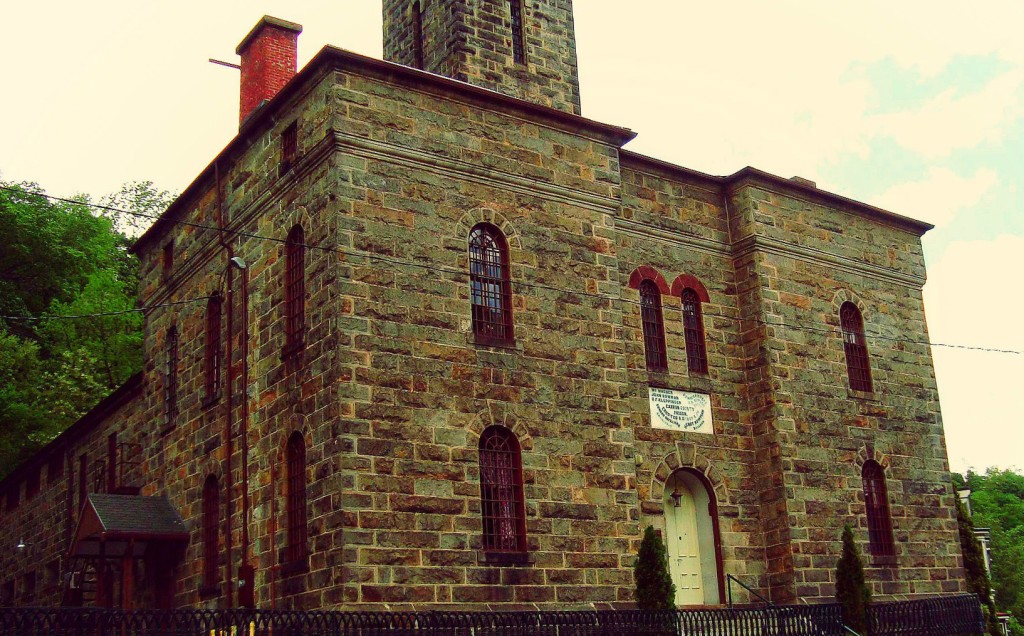Resembling a fortress standing guard over the town of Jim Thorpe (formerly known as Mauch Chunk), the historic Old Jail Museum is a beautiful two-story stone structure. The prison was opened in 1871 and went through years of murders and criminals, many of whom left their mark (you’ll understand below). After hundreds of inmates passed through the doors, it was closed in 1995 and then purchased by Tom McBride and his wife, Betty Lou, of Jim Thorpe.
The building contains approximately 72 rooms, including 27 cells, basement dungeon cells used as solitary confinement until 1980, women’s cells on the 2nd floor, and the warden’s living quarters across the front of the building.
The building is best known as the site of the hanging of seven Irish coal miners known as Molly Maguires in the 1800’s. The Molly Maguires were a secret organization, composed mainly of Irish Catholics, that started one of the first labor movements in the country. Since the Irish were not well regarded by society at the time, one of the only jobs they could get in PA was working in the local coal mines. It was intense physical labor where workers only got pennies for their long hours, bought all their own work equipment from the bosses, had to pay rent to the coal bosses who owned their houses, and could only shop at the coal bosses’ town store. The Molly Maguires who had enough of the slave-labor grew tired one night and murdered coal management and vandalized the mines and mining equipment. They were later found guilty.
On June 21, 1877, today known as the Day of the Rope, Alexander Campbell, Edward Kelly, Michael Doyle and John Donohue were hanged at the same time on gallows erected inside the Old Jail Museum cell block. On March 28, 1878, Thomas P. Fisher was hanged here, and on January 14, 1879, James McDonnell and Charles Sharp were hanged on the same gallows.
Historians today feel the Molly Maguire trials were a surrender of state sovereignty. A private corporation (a coal/railroad company) initiated an investigation through a private detective agency (Pinkerton Detectives), a private police force (the Coal & Iron Police) arrested the alleged offenders, and private attorneys (employees of the coal companies) prosecuted these men. The Commonwealth of Pennsylvania provided only the courtroom and the gallows.
Before their hanging, the men proclaimed their innocence and today historians believe many of the condemned men were falsely accused of murder. Before his hanging one of the man, thought to be Alexander Campbell, he put his hand on the dirty floor of his cell and then placed it firmly on the wall proclaiming, ” This hand print will remain as proof of
my innocence.” That hand print is visible today for everyone to view even though past wardens tried to eradicate it by washing it, painting it, and even taking down part of the wall and re-plastering it.
Besides the hand print, visitors will see a number of supernatural occurrences, including shadows, footsteps and loud bangs from the solitary confinement cells. Legends say that these are the spirits of inmates or the ghost of the warden himself “checking up”. In the wardens apartment objects will move near the old kitchen area, assumed to the wardens wife who would cook for the prisoners herself. The Old Jail Museum is open for ghost tours during the year at various times of the year so go take a look for yourself!
Share your Instagram pictures, use
Try to Scare me is NOT intended as a guide to trespassing. We present these sites, locations and stories as local unwritten history and the legends surrounding it that are told to us while traveling. Although we provide locations, and some directions, these articles are intended to be read with the knowledge that some places cannot be visited. We do not encourage trespassing onto private property and do not encourage trespassing to obtain articles, videos, pictures and other evidence to be submitted. Trespassing is illegal and those who disregard this advice will (in most cases) be arrested and charged.
